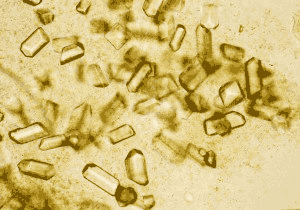Gout is a very painful form of arthritis caused by elevated levels of the metabolic waste product uric acid in the body. For most people, uric acid is dissolved in the bloodstream and passed through the kidneys. But for gout sufferers, the excess uric acid forms tiny, needle-shaped crystals that collect and deposit in the joints. The tiny crystals literally pierce through the cell walls of white blood cells, signalling other white blood cells to come to the rescue, which can result in a cascade of inflammation leading to a full-blown, debilitating gout attack. Triggers for gout attacks include consuming too much purine-rich food, drinking alcohol to excess, dehydration, and elevated levels of stress.


Most people experience gout for the first time in one of the big toe joints, but many other joints and areas of the body can be affected. The symptoms of a gout attack in the affected joint is stiffness, redness, heat, and of course a lot of pain and extreme sensitivity. If gout is allowed to progress, chalky deposits of uric acid (known as tophi) can appear as lumps under the skin. Uric acid can also collect in the kidneys and cause kidney stones.
Gout is tricky to live with because someone with gout does not often realize that the stiffness and pain they are feeling in their joints is not just 'getting older' but actually a chronic, low-level arthritic inflammation that sometimes develops into a full-scale gout attack. If you have ever experienced a gout attack or had a blood test result that showed a high uric acid level, it is very important that you stay hydrated and lower your blood uric acid level.